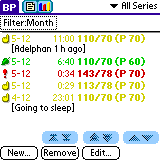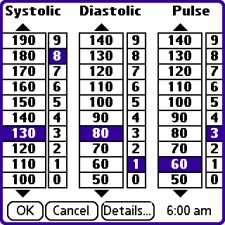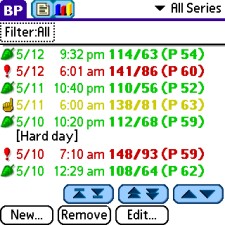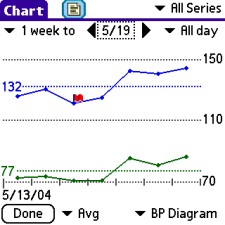Disclaimer
I am not a medical doctor. This is a software review by a layman, and nothing you read here should be misconstrued as medical advice. On matters medical you should always consult with your physician for proper examination, evaluation, advice and, if needed, medications for treatment of high blood pressure or any other serious malady.
High Blood Pressure – "the silent killer."

Do you know what your blood pressure is? You not only should know, but, the older you get, or if your family or racial group is prone to high blood pressure, you should care. Care a lot. Untreated high blood pressure, also known as "hypertension" is a serious condition, and if left untreated can cause serious problems, even crippling and fatal ones, like stroke, or do permanent, non-reversible damage to your internal organs, especially your kidneys.
Before continuing on, or after reading this review, I urge you to check out The American Heart Association's high blood pressure site and spend some time with their blood pressure risk calculator and other tools you'll find there.
"I feel fine. Why should I bother with this?" you might ask yourself..
According to recent estimates, nearly one in three U.S. adults has high blood pressure, but because there are no symptoms, nearly one-third of these people don't know they have it. In fact, many people have high blood pressure for years without knowing it. Because the most sinister thing about high blood pressures is that it is asymptomatic (it usually has no outward or obvious symptoms) it's called "The silent killer."
If youÂ’re young and reasonably healthy, your doctor usually checks your weight and blood pressure each time you go in for an exam, other problem, or any other regular visit, but that might only be once or twice a year.
So what IS blood pressure?
As the AHA's site explains, your blood pressure level is a combination of two numbers: the higher number: "systolic" (which represents the pressure against your blood vessels when your heart is contracting – pumping out blood), and the lower number: "diastolic" (the pressure against your blood vessels when your heart relaxes and blood returns to the heart).
Blood pressure is measured in millimeters of mercury, or "mm Hg" and is expressed as these two numbers, with the systolic pressure always the first, thus a reading of 148/86 is read aloud as "one forty- eight over eighty-six."
If your numbers are good, around 120/80, known as "normal", generally speaking, no problem. As you get older (and blood pressure typically increases with age).. or if you're running higher numbers constantly, you could fall into the categories of pre-hypertension (the caution range), Stage 1 hypertension (the high range), or Stage 2 hypertension (the very high range).
High blood pressure is a serious condition, but it can be controlled with relatively inexpensive prescription medications, which youÂ’ll probably have to take every day for life. But unless you're an MD, donÂ’t even think about medicating yourself to control high blood pressure. Your doctor is the one whoÂ’s qualified to prescribe for you, and recommend lifestyle changes to get your numbers down to normal and keep them there.
Again, IÂ’m not a doctor, and IÂ’m not giving medical advice here, so the AHA's Web site is an excellent starting place to read up on the subject, take their online self-evaluation tests and build a knowledge base from which to start, then talk to your doctor on your next office visit.
If you learn you're in a high risk category and have high blood pressure, and your doctor prescribes medicines to control it (and your doc may have to try out different combinations of medications until the best one(s) for you are determined, as there are many, and the same drugs are not the right ones for everybody) he or she will probably want you to monitor your numbers to make sure those prescription medicines are doing their job.
Blood pressure monitors – dos and don'ts
Obviously, you don't want to have to visit your doctor every day to have your blood pressure checked, so get yourself a home blood pressure measurement device, and use it daily to check yourself.
You don't have to get obsessive about it and check your blood pressure all day long, as the numbers change during the course of the day anyway, and they'll be different in the morning when you awaken, when you're at work, driving, relaxing, or under stressful situations. But when you're on medication to control your blood pressure, those numbers shouldn't vary wildly, and without an accurate blood pressure monitor, you simply won't know what your numbers are by how you feel. Remember, high blood pressure has no physical symptoms.
Forget those sit-down meters you've probably seen at your local pharmacy or supermarket. TheyÂ’re horribly and notoriously unreliable, kids play with them, they're rarely re-calibrated, and blood pressure readings should be taken when you've been sitting, at rest, for about ten minutes, not after you've just been flogging through stressful traffic, or walked through a store. This is your life, so accuracy is important.
Omron is one well-respected company that makes many models of reliable, battery-powered electronic blood pressure monitors, and about $50.00 to $75.00 will get you a compact, easy-to-use wrist or arm monitor at your local drug store or from online merchants.
These inexpensive devices are accurate to about plus or minus 2%, which, according to my doctor, is fine. They're easy to use (especially the wrist models) and it takes half a minute to get a reading. The latest generation fancier home blood pressure monitors have memory features to store up to 90 previous readings. Forget "finger" style monitors – they too are not accurate; go with the compact electronic wrist or arm style, and don't buy someone else's used one. You don't know how often it's been used, and since these devices use an inflatable cuff, the slightest pinprick of a hole can render them useless. Buy a new one, sealed in the box, with a warranty. This IS your life we're talking about here, so don't cheap out.
A visit to a doctor's office is often stressful. No one I know enjoys it, and even though the doctor or nurse uses professional-quality gear, just the anxiety of being in the office can cause higher than normal blood pressure readings, so checking your numbers with a modern electronic device when relaxed at home often provides more accurate numbers.
Tracking those numbers
While those devices described above, depending on price, have features that let you scroll through previous readings, they're just the starting point.
Once you do start checking your blood pressure on your own, or if your doctor puts you on medications and asks you to monitor your blood pressure, youÂ’ll want some way to record, store, track and chart those numbers.
UTrackSys.comÂ’s Blood Pressure (UTSBP) software is an excellent, reliable, feature-packed choice. When I learned I had high blood pressure a few years ago, and was put on medication to control it and bought myself a wrist monitor, I tried some other PalmOS blood pressure tracking programs, including a couple of free ones, but this is truly a case of "you get what you pay for." The free programs were mostly junk. USTBP is high quality, and extremely easy-to-use.
Entering your blood pressure readings into UTSBP couldn't be any easier.

Use your home monitoring device to get the numbers, then just launch the program and tap “new”, tap your three readings (systolic, diastolic, and pulse) from your monitor onto a beautifully laid out input screen, and the data is time-stamped automatically and stored in its internal database. You don’t have to type or write anything, unless you want to add some comments about the reading, which are stored with it.
After accumulating some readings, UTSBP lets you see them in a colorful, scrolling list format that you donÂ’t have to be a rocket scientist to understand. You can change the listÂ’s date ranges, modify the threshold colors of the numbers (green for good, yellow for a bit high, red for high, or whatever you want), and chart and graph the data easily, in many ways. This not only lets you know your medication is doing its job, but you can even spot changes caused by drug interactions and then talk to your doctor.
If you learn you have high blood pressure, and you're under medication to control it, you have to be careful about what over-the-counter ("OTC") medications you take. Common cold and flu medicines containing antihistamines and decongestants can ruthlessly raise your blood pressure, especially when taken longer than the instructions recommend. Recently, a new generation of cold medicines without blood pressure elevating decongestants has appeared on store shelves.
Ibuprofen, a common NSAID pain killer and anti-inflammatory drug, sold under various brand names, can interact with, and cause some blood pressure medications to stop working correctly. Your home monitor and UTSBP will help you spot unexpected blood pressure trends quickly.
Features galore
UTSBP has a ton of filtering features, charts, graphs, and tables to view your blood pressure and pulse readings in many ways.


One of its many useful features lets you export your readings to the Memo Pad, and even send your blood pressure readings directly to your doctorÂ’s email address.
For its ridiculously low price, this is high quality software, and the basic features are logical and fast to learn. It was designed to be easy to use to make you WANT to use it. Who said medical software can't be fun too?
As with any software, read the manual to dig deeper into what it can do. UTrackSys provides excellent and fast online support, free upgrades when a new version comes out, and an emailed newsletter. A free trial version of UTSBP lets you play with it and enter up to 20 readings. After that, youÂ’ll probably want to buy it. For software this good, the price is a steal.
UTS offers other health-related tracking programs for those who need or want to track their weight and for diabetes patients, and you can buy UTSBP alone, or in a bundle with others. All of them come with a trial version of UTrackSys' "Universal Tracking System" which installs as a sort of control and organizing center for the plug-ins like UTSBP. The Universal Tracking System itself is pretty complex, so if you simply want a top quality, feature-packed PalmOS blood pressure tracker, you never even have to use it and can simply use UTSBP by itself.
Next Page: Conclusion >>